The best things to do during a visit to Siem Reap and the amazing Angkor Temples.
Being home to one of the world’s most spectacular human creations - the World Heritage listed temples of Angkor - is a good start from a traveller's perspective. But for us, the Angkor temples and their home in the mellow town of Siem Reap make for a very good all round travel experience. Getting around the amazing temples is part of the fun, their setting in dense forest is dramatic, there are loads of very cool mid range and high end hotel options where you can break up your temple roaming, and the culinary options are also growing fast. Not a bad a traveller portfolio at all!
Take your time - visit the temples early and late.
Travel slowly. It’s a good motto for all travel, but it’s especially true at Angkor. The more time you spend climbing amidst the ruins, the more you’ll appreciate their raw scale and delicate beauty.
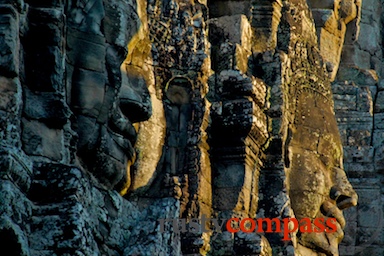
Photo: Brendan GilbertLate afternoon at the Bayon.
We recommend at least three days for temple exploration. To make sure it’s fulfilling, you’ll need to take your time and take plenty of breaks. Even the most committed explorer can suffer temple fatigue.
We suggest spending three or four hours in the early morning amongst the ruins followed by a good break in the heat of the day - perhaps 3 or 4 hours. Then head back for the late afternoon for 2 or 3 more hours.
If you’re staying in one of Siem Reap’s delightful boutique hotels, you may want to indulge yourself and stay a full week. You won’t run out of temples to discover, you’ll be able to explore the town and you’ll also be able to rest and relax. Siem Reap’s vibe is conducive to chilling.
Explore the edges
You’re going to need to visit the most popular temples - Angkor Wat, Bayon and Ta Prohm. But that should be where your conventional journey finishes. Stay away from crowds as best you can and spend time at the less visited temples. You’ll be pleased with what you find. It’s still possible to capture the buzz of discovery at Angkor - especially when you’re away from the crowds.
The wet season
The wet season (June to August) is the low season for travel to Angkor. That in itself is a bonus. But it’s during the wet season that Angkor is most beautiful - lotus flowers blossom in temple moats, myriad casts of light descend from changing skies, rice paddies are lush with life and Lake Tonle Sap engulfs vast swathes of countryside.
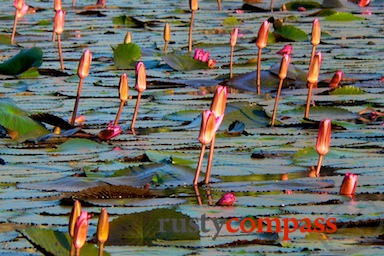
Photo: Mark BowyerLotus flowers before the rains come.
Expect some spectacular torrential downpours but it’s rare that these will last beyond a couple of hours. The humidity and heat may be a bigger consideration - but it’s always hot at Angkor.
Keen photographers should definitely note that the wet season is the most visually rich time to visit.
Take a book
Angkor’s beauty and power will strike you even if you know very little or nothing about them. But if you do make a small investment in trying to understand some of the history and symbolism, the temple experience will be ever more profound. And there are plenty of paperback books with great photography and illustrations that you can easily fit in your pack.
Seek out a quiet scenic space, put your feet up and spend fifteen minutes reading about each the temple you visit.
We recommend -
Angkor - Dawn Rooney
The Treasures of Angkor - Marilia Albanese
Ancient Angkor - Michael Freeman, Claude Jacques
Cycling and tuk tuks
The major temples close by Siem Reap are easily accessed by bicycle. Good flat roads, light traffic and lovely tree cover mean that cycling can be a real highlight of a visit.
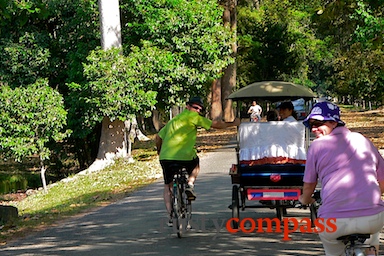
Photo: Mark BowyerCycle, tuk tuk or both
And if cycling’s a stretch, you can still avoid car travel by taking a tuk tuk - also lots of fun.
Cool accommodations
Siem Reap offers an amazing range of tasteful small well priced boutique hotels. They can be a great base for temple exploration. They can also be very nice places to be in their own right for an extended break.
In the mid range, we’re impressed by the Frangipani Villa Hotel, the Temple Hotel, Golden Banana hotels as well as the more expensive Siddharta and Pavillon Indochine. What they lack in slickness they more than compensate in cosiness and character.
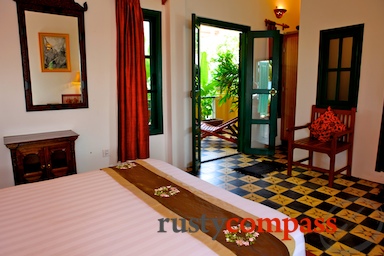
Photo: Mark BowyerModerately priced hotels are nicely done - the Golden Banana.
At the top end, the choices are many. The Amansara is beautifully done but unless money is no object, the value proposition may be questioned. Of course that’s part of the point.
Raffles Grand d’Angkor offers history and luxury and expansive grounds. Its stylistic antithesis, the Hotel de la Paix, offers cool, modern, luxury and design innovation. La Residence d’Angkor and the Victoria Angkor Resort are also very good high end options.
Friendly locals
You’ll likely find your interaction with the locals a highlight. Tuk tuk drivers, tour guides, hotel staff - even the people that manage the temples, are friendly, helpful and eager to make your stay a happy one. And while some sellers may at times overstep the mark, even they tend to be good humoured.
And the not so good.....
Poverty and beggars
Cambodia is one of Asia’s poorest countries so the presence of poverty and begging is unsurprising. Some of the harassment by sellers - often children - can be overly persistent and annoying - especially at the temples. Keep your cool and stay friendly. You won’t feel good later if you let the aggravation get to you. The less you react, the less you’ll be hassled.
Crowds
As one of the world’s great attractions, the temples of Angkor are finally receiving the kind of traveller attention they deserve - and that means crowds. Compared with other world famous sites though - think the Sistine Chapel. the Taj Mahal or the Pyramids - the temples seem positively quiet. And they’re helped further by the fact that they’re spread across many complexes over many kilometres.
If you give yourself time, avoid overrated spots like sunset at Phnom Bakheng, and make sure you include some lesser visited temples, you should be able enjoy some unforgettable moments of solitude amidst the atmospheric ruins. Travel in the wet season (May to August) will also help you avoid the crowds.
Tonle Sap
The floating village on lake Tonle Sap at Chnong Kneas has become very unpleasant. From the nasty standover merchants that manage the boat trip to the harassment and tourist traps that are part and parcel of the trip itself, this place is probably best avoided altogether. Those travelling on organised tours may avoid the nasty guys that “manage” the allocation of boats but they’ll still encounter one of the great tourist traps in full swing.
The Tonle Sap excursion from Kompong Phluk is a much better bet.
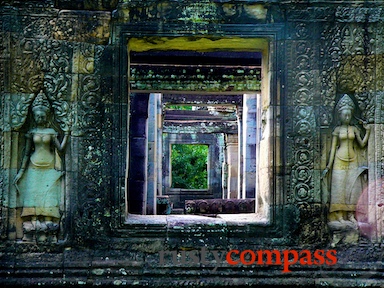
Photo: Mark BowyerTa Som temple
Who owns the temples?
It’s no coincidence that one of Asia’s poorest countries is also one if its most corrupt. And it shouldn’t surprise that the enormous profits made from controlling the temples have been under a cloud since the management contract was awarded without contest to Sokha Company in 1999. While some of the profits find their way into preservation, most are channelled away in favour of the usual government cronies.



Twitter: @rustycompass
Rusty Compass is an independent travel guide. We’re focused on providing you with quality, unbiased, travel information. That means we don't receive payments in exchange for listings and mostly pay our own way. We’d like tourism to be a positive economic, environmental and cultural force and we believe travellers deserve disclosure from publishers. Spread the word about Rusty Compass, and if you're in Saigon, pop in to The Old Compass Cafe and say hi. It’s our home right downtown on Pasteur St. You can also check out our unique tours of Ho Chi Minh City and Sydney at www.oldcompasstravel.com Make a financial contribution using the link below. Even small amounts make a difference. Thanks and travel well!